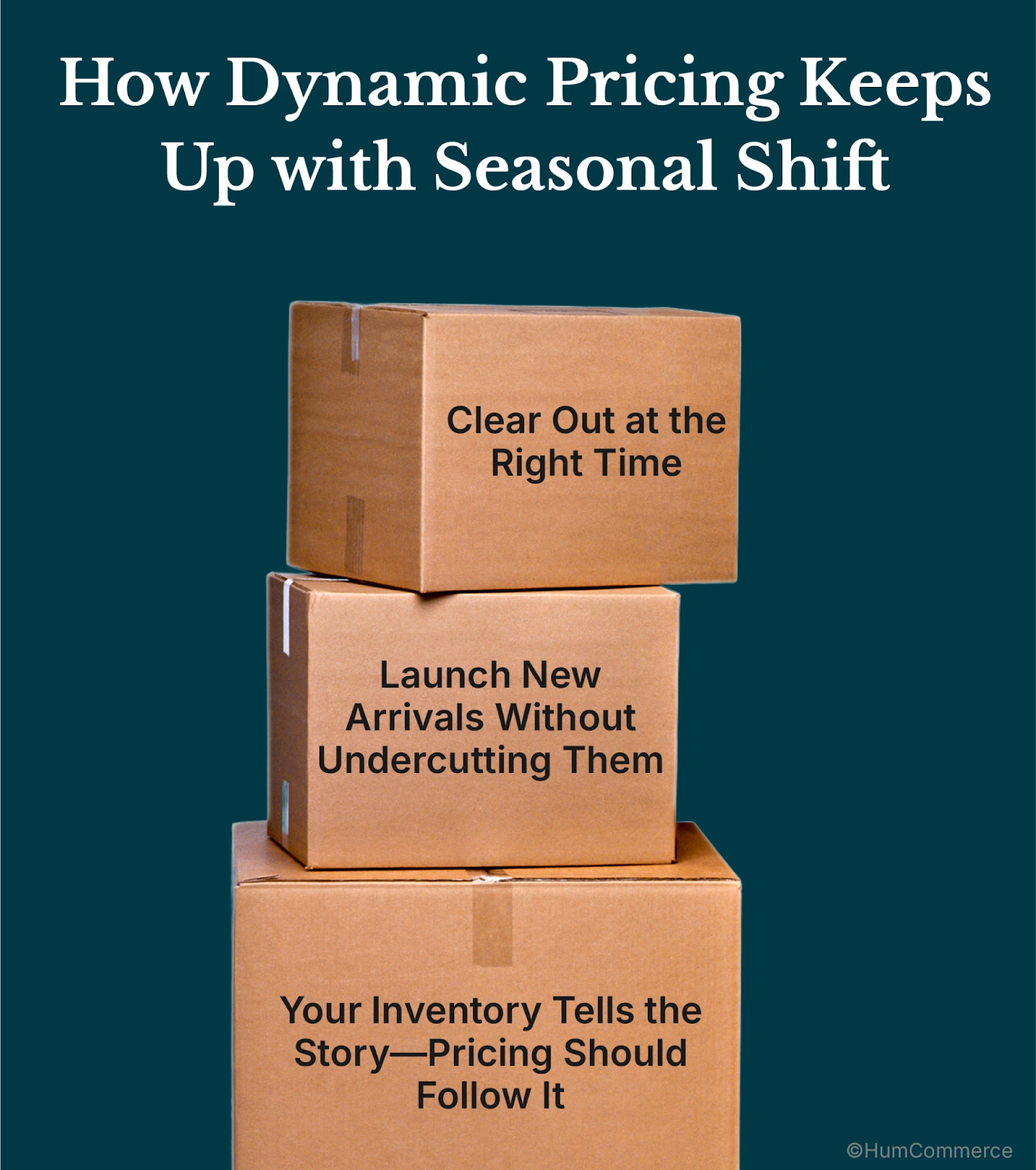Key Takeaways
- Why static pricing slows down B2B apparel and footwear sales
- Common pricing challenges wholesalers face and how to solve them
- How dynamic pricing tools improve margins and speed
- Best practices to implement dynamic pricing without chaos
- A real-world case of faster quoting and better pricing accuracy
One month, stocks are flying off the shelves. The next? Dead stock.
Your bestsellers from March are gathering dust in May. Meanwhile, your competitors already cleared theirs because they moved faster. Right price, right time.
In apparel and footwear wholesale, timing is everything.
One slow move on pricing, and suddenly you’re sitting on stock that isn’t moving and margins that are shrinking.
That’s the risk with fashion – what’s hot today might be dead weight next month.
Dynamic pricing helps you keep up. It lets you respond quickly—whether demand spikes, competition shifts, or seasons change—without digging through spreadsheets or scrambling last-minute.
So how exactly does it work for wholesalers? And more importantly, how can it help you move faster, protect profits, and stay ahead?
Let’s get into it.
The Unique Pricing Challenges Faced by Apparel and Footwear Wholesalers
Fashion moves fast and so do the challenges that come with pricing it.
If you’re a wholesaler dealing with apparel or footwear, you’re navigating a mix of styles, sizes, fabrics, colors, and regional demand shifts, all of which change by the season (or even faster).
Here’s what gets in the way:
- Trends change faster than your spreadsheets can keep up. A bestseller in March can become dead stock by May. But if your prices don’t move with the market, you’re either losing sales—or losing margin.
- Too many SKUs, not enough time. Every product line comes with its own maze of sizes, colors, and styles. When one pricing error affects thousands of items, manual updates stop being an option.
- Tiered pricing turns into a juggling act. Wholesale rates, volume discounts, and contract pricing all shift from buyer to buyer. A small change for one account often means a big backend scramble.
- Late price drops mean piled-up stock. If you don’t adjust fast enough, that inventory you were banking on ends up stuck on shelves—tying up cash and warehouse space.
- You’re under pressure to stay competitive, constantly. Cut prices too late, and buyers move on. Cut too early, and your margins vanish. Getting the timing wrong is costly either way.
The result? You’re always playing catch-up.
Instead of setting the pace, your pricing team spends most of its time reacting. Dynamic pricing flips that script—giving you the tools to act faster, smarter, and with more control.
Managing tiered pricing across thousands of SKUs isn’t just time-consuming—it’s a breeding ground for errors. That’s why forward-thinking wholesalers are moving toward integrated tech stacks that connect their ERP and eCommerce systems, automate pricing rules, and cut down on manual rework.
Read how smarter system integration simplifies wholesale operations →
Why Fixed Pricing Falls Apart and What Smart Wholesalers Are Doing Instead?
Pricing can be different things.
It’s about timing, pressure, and staying one step ahead of both your buyers and your competitors.
But here’s the thing: most pricing still runs on rigid rules. Static tiers. Excel sheets. Updates that happen once a quarter, if that.
That’s fine, until the market shifts. A trend fizzles. Or a competitor undercuts you overnight.
Dynamic pricing gives you flexibility. So when something moves—demand, inventory, competitor pricing—you can respond without scrambling.
It helps you:
- Adjust prices mid-season without redoing the whole catalog
- Offer different rates to different buyers without manual overhead
- Catch early signs of slow-moving stock and react while there’s still margin left
And the biggest benefit? You stop relying on gut instinct alone. Instead of guessing what to discount or when to hold the line, you’ve got actual signals—from real sales patterns—to guide the call.
In an industry where timing defines margin, dynamic pricing gives you the room to breathe and the edge to move first.
What Smart Wholesalers Get Right About Dynamic Pricing?
One thing we know by now is that fashion doesn’t wait.
Trends shift fast and so do your buyers’ expectations. If your pricing lags behind, you’re either losing orders or watching your margins erode.

Dynamic pricing helps you move at the pace of your customers without turning pricing into a full-time fire drill.
Update Prices in Real Time, Not Weeks Later
Forget chasing spreadsheets every time markdown season hits.
With dynamic pricing, your system automatically adjusts prices based on current stock levels, seasonality, and market demand.
Example: A footwear wholesaler with 800+ SKUs used dynamic pricing to run end-of-season promotions across all sizes and color variants in one click—clearing out inventory two weeks faster than the previous year.
Protect Margins Without Playing It Safe
You know which SKUs fly off the shelves and which ones collect dust. Dynamic pricing lets you hold prices for high-demand items and push selective discounts for slower sellers.
Example: A sports apparel distributor segmented products by demand tiers—keeping prices firm on high-demand activewear while rotating discounts on less popular items. They grew margin contribution by 12% in just one quarter.
Price Differently for Different Buyers
You don’t want your big-box retailers and independent boutiques seeing the same price. Dynamic pricing lets you automate tiered pricing, volume-based discounts, and contract-specific rates—without manual overrides.
Example: One streetwear wholesaler synced dynamic pricing with account types in their ERP—so VIP clients got exclusive pre-season rates automatically. Fewer errors. Higher reorder rates.
Stay Ahead of the Curve Without Guesswork
Why wait for your competition to undercut you? With dynamic pricing, your system tracks market changes and competitor behavior so you can adjust early—not after sales drop.
Example: A fast-fashion distributor got automated alerts when two key competitors dropped prices on a core SKU. Within hours, their pricing auto-adjusted—maintaining sales momentum without over-discounting.
Note: While advanced dynamic pricing systems can track competitor prices and trigger automated price adjustments, this isn’t standard in all dynamic pricing solutions or basic eCommerce platforms. Features like competitor monitoring and real-time repricing typically require specialized tools or integrations. If you want this level of automation, look for solutions that specifically support competitor price tracking and automated rule-based updates.
Fewer Errors, More Strategy
Every price change done by hand is a risk—and a time sink. Dynamic pricing removes the guesswork and the grunt work, so your team can finally focus on growth, not cleanup.
Example: A regional apparel wholesaler cut pricing-related support tickets by 40% in one season—just by automating updates across their B2B portal, ERP, and eCommerce platform.
How Dynamic Pricing Keeps Up with Seasonal Shift
We’ve talked about what you can do with dynamic pricing, now let’s talk about how it stays ahead of the curve, season after season.

Clear Out at the Right Time
Instead of waiting for quarterly reports to flag dead stock, dynamic pricing tools track sell-through in real time. If jackets aren’t moving by mid-February, markdowns go live—automatically, across every channel.
This means fewer clearance fire drills and more controlled inventory turnover.
Launch New Arrivals Without Undercutting Them
Got a fresh drop for summer? You shouldn’t be discounting it in week one. With the right setup, you can hold pricing steady through launch windows, run early-access promos for top buyers, or create time-based incentives that protect your margins while still driving volume.
Your bestsellers get time to prove themselves without margin leaks on day one.
Your Inventory Tells the Story—Pricing Should Follow It
If your pricing and inventory aren’t talking to each other, you’ll always be two steps behind.
Dynamic pricing integrates with your inventory and order systems, so out-of-stock items stop showing up in promo lists, and overstocked SKUs can be nudged with subtle, timely discounts.
Bottom line: When your pricing responds to what’s happening on the ground, in your warehouse, in the market, and in your sales reports- you stay ahead without scrambling.
How Smart Wholesalers Roll Out Dynamic Pricing (Without Breaking Everything)
Let’s make sure your prices make sense at all times without burning hours every week.
Here’s how experienced apparel and footwear wholesalers make it work:
1. Keep your pricing guardrails in place.
You’ve got rules for a reason. Maybe you don’t discount new arrivals until week 6. Maybe key accounts always get a certain margin.
Start by locking those rules in. Dynamic pricing shouldn’t override your logic—it should enforce it without constant babysitting.
2. Group your customers by buying behavior.
Forget trying to build endless pricing tiers. Instead, look at how people buy.
Your national chains reorder weekly. Your independent boutiques wait for end-of-season. Segmenting by behavior lets you offer better prices without overcomplicating your backend.
3. Make your pricing engine part of the system, not an extra tab.
It has to talk to your eCommerce platform, inventory system, and ERP.
Otherwise? Prices get out of sync. Orders go through at the wrong rates. Sales calls become damage control.
Pick a setup where updates flow cleanly across all your tools. This often requires an eCommerce platform built with B2B complexities and deep ERP integration at its core—so updates don’t get stuck between systems.
4. Don’t “set and forget” your pricing.
Think of it like your product catalog, it needs regular check-ins.
Maybe a weekend markdown helped clear winter stock. Or maybe your bestsellers didn’t need that 10% off after all.
Look at what actually moved, where margins held, and what fell flat.
Then adjust. Pricing should be a habit.
Case Study: Lessons from a Safety Manufacturer
Context:
While this case features a welding safety manufacturer, the learnings directly apply to wholesalers in fast-moving industries like fashion and footwear—where pricing delays mean lost revenue.
The Challenge
The quoting process was slowing everything down. Reps would pull up the system to send out a price—and just loading the quote builder took almost 40 seconds. It doesn’t sound like much, but when you’re in the middle of a conversation with a buyer, it’s enough to lose the deal.
The bigger issue? None of the tools talked to each other. Salesforce had one set of data, the CPQ tool had another, and Duchess—their old backend system—was completely out of sync.
So pricing updates got missed. Quotes didn’t reflect real-time stock. And approvals? Stuck in email threads with no tracking. The ops team ended up spending hours every week fixing things that should’ve just worked.
It’s the same kind of problem you run into in wholesale—prices shift mid-season, but if your systems can’t keep up, you’re left with bad data and unsold stock.
The Fix
Instead of replacing everything, they focused on tight integration:
- Standardized APIs created a single flow between platforms
- Quote data synced in real time with ERP and product catalogs
- All price, product, and buyer logic flowed cleanly across the stack
- Backend was restructured to support fast updates—without breaking workflows
The Result
- Quote turnaround dropped by 88%
- 100% data sync between systems meant no rework, no delays
- Sales teams could react instantly to requests and competitive shifts
Conclusion: Price with Confidence, Not Catch-Up
In fashion wholesale, timing is everything. Trends move fast. Buyers expect your prices to keep up—and if they don’t, they’ll move on.
Dynamic pricing isn’t about changing prices constantly. It’s about changing them with purpose. When done right, it helps you clear slow stock, protect margins on fast sellers, and stay in step with the market—without turning pricing into a firefight.
That’s where HumCommerce comes in. We work with apparel and footwear wholesalers to bring structure to dynamic pricing—from setting smart rules to syncing your tools so you’re not chasing spreadsheets every time seasons shift.
Want to see how it could work for you? Let’s make your pricing as fast as fashion.








